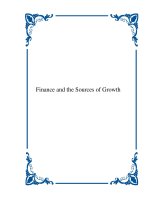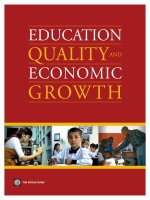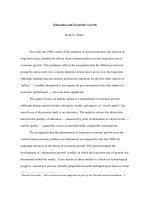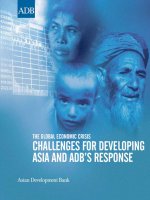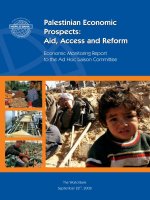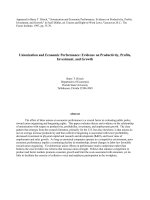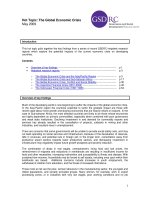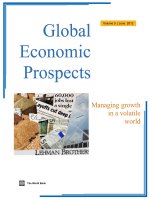Global Economic Prospects 2010 - Crisis, Finance, and Growth pptx
Bạn đang xem bản rút gọn của tài liệu. Xem và tải ngay bản đầy đủ của tài liệu tại đây (4.95 MB, 184 trang )
2010
Crisis, Finance, and Growth
2010
Global
Economic
Prospects
Global
Economic
Prospects
Global
Economic
Prospects
2010
Global
Economic
Prospects
Crisis, Finance, and Growth
© 2010 The International Bank for Reconstruction and Development / The World Bank
1818 H Street NW
Washington DC 20433
Telephone: 202-473-1000
Internet: www.worldbank.org
E-mail:
All rights reserved
1 2 3 4 13 12 11 10
This volume is a product of the staff of the International Bank for Reconstruction and
Development / The World Bank. The findings, interpretations, and conclusions expressed in
this volume do not necessarily reflect the views of the Executive Directors of The World Bank
or the governments they represent.
The World Bank does not guarantee the accuracy of the data included in this work. The
boundaries, colors, denominations, and other information shown on any map in this work do
not imply any judgement on the part of The World Bank concerning the legal status of any
territory or the endorsement or acceptance of such boundaries.
Rights and Permissions
The material in this publication is copyrighted. Copying and/or transmitting portions or all of
this work without permission may be a violation of applicable law. The International Bank for
Reconstruction and Development / The World Bank encourages dissemination of its work and
will normally grant permission to reproduce portions of the work promptly.
For permission to photocopy or reprint any part of this work, please send a request with
complete information to the Copyright Clearance Center Inc., 222 Rosewood Drive, Danvers,
MA 01923, USA; telephone: 978-750-8400; fax: 978-750-4470; Internet: www.copyright.com.
All other queries on rights and licenses, including subsidiary rights, should be addressed to the
Office of the Publisher, The World Bank, 1818 H Street NW, Washington, DC 20433, USA;
fax: 202-522-2422; e-mail:
ISBN: 978-0-8213-8226-4
eISBN: 978-0-8213-8227-1
DOI: 10.1596/978-0-8213-8226-4
ISSN: 1014-8906
Cover photos: © iStockphoto.com/burakpekakcan (sky); © iStockphoto.com/mikeuk (sea)
Cover design: Critical Stages
The cutoff date for the data used in this report was January 8, 2010. Dollars are current
U.S. dollars unless otherwise indicated.
Foreword xi
Acknowledgments xiii
Abbreviations xv
Overview 1
The acute phase of the crisis is over 1
Impact of the boom period on developing-country potential 4
Medium-term implications of the bust for finance in developing countries 8
Medium-term impact on the supply potential of developing countries 12
Conclusion 14
References 14
Chapter 1 Prospects for Developing Economies 15
Recent developments in financial markets 18
Global growth 22
Prospects for high-income countries 23
Prospects for developing economies 25
Regional outlooks 26
Commodity markets 31
Inflation 35
World trade 36
Narrowing global external payment imbalances 38
Uncertain prospects 39
The impact of the crisis on the very poor 41
Policy implications for developing countries 42
Notes 43
References 44
Chapter 2 The Impact of the Boom in Global Finance on Developing Countries 45
Financial innovation, high-income finance, and the liquidity boom 47
Novel channels for credit creation 50
Developing-country finance during the boom 53
v
Contents
Real-side consequences of the surge in global finance 61
Concluding remarks 70
Notes 71
References 72
Chapter 3 Medium-Term Impacts of the Crisis on Finance and Growth in Developing
Countries 75
The impact of post-crisis regulatory and structural changes 77
Implications of a potential developing-country retreat from financial integration 88
The impact of higher borrowing costs 94
Strategies for dealing with a weaker international finance system 104
Implications for the global balance between savings and investment 107
Conclusion 108
Notes 109
References 112
Appendix: Regional Economic Prospects 117
East Asia and the Pacific 117
Europe and Central Asia 123
Latin America and the Caribbean 131
Middle East and North Africa 139
South Asia 146
Sub-Saharan Africa 154
Notes 163
References 164
Figures
O.1 Financial conditions have stabilized 2
O.2 Developments in high-income countries have driven the industrial
production cycle 2
O.3 The downturn in developing countries has been deeper and more broadly based than
during previous recessions 3
O.4 Selected indicators of macroeconomic stability in developing countries, 2007 5
O.5 The cost of risk in high-income countries fell sharply during the boom 6
O.6 Developing-country potential output growth was boosted by low borrowing costs 7
O.7 Foreign participation in selected emerging equity markets 9
O.8 FDI as a share of investment in developing countries, 1995−2008 10
O.9 Very volatile external debt flows pose serious macroeconomic challenges 10
O.10 Indicators of regulatory quality 12
O.11 Private credit provision is strongly correlated with per capita incomes 12
O.12 Higher borrowing costs result in a permanent decline in developing-country
GDP 13
1.1 Financial markets’ stabilization has partially restored pre-crisis financial conditions in
developing countries 19
1.2 Syndicated bank lending by region, 2008 and 2009 20
1.3 FDI flows to developing countries 21
1.4 External financing needs as a share of GDP, 2010 22
C o n t e n t s
vi
1.5 Growth in industrial production 23
1.6 Change in stock building as a contribution to GDP growth in G-3 countries 24
1.7 Dispersion of GDP growth results in the first quarter of 2009 25
1.8 China’s stimulus program yielded a pickup in import demand 27
1.9 Nonperforming loans rise across much of Europe and Central Asia 28
1.10 In Latin America EMBI-stripped spreads retreat as investor confidence
returns 28
1.11 Lower oil prices and production yield sharp decline in oil revenues during 2009 30
1.12 South Asia’s external position improves in most countries on lower oil prices and
decline in domestic demand 30
1.13 Quarterly GDP data point to output stabilization in Sub-Saharan Africa 31
1.14 Real commodity price indexes 32
1.15 OPEC spare capacity 33
1.16 Global stock-to-use ratio of key agricultural markets (excluding China) 34
1.17 Real commodity prices 35
1.18 Inflation in low-, middle-, and high-income countries 35
1.19 Core inflation in high-income countries 35
1.20 Food prices in low-income countries 36
1.21 World trade is recovering 36
1.22 International tourist arrivals 37
1.23 An easing of global imbalances 39
1.24 U.S China imbalances have diminished markedly 39
1.25 Comparison of 2015 poverty forecast, GEP 2009 versus GEP 2010 43
2.1 Since the early 2000s, credit expansion has grown more than twice as fast as
nominal GDP 49
2.2 High-income GDP and trade growth do not explain the acceleration in developing-
country economic activity 50
2.3 Notional value of derivative transactions, 2002–08 52
2.4 Share of commercial bank and securitized assets in total credit held by U.S. financial
sector, 1995–2008 52
2.5 The cost of risk in high-income countries fell sharply during the boom 55
2.6 Developing-country interest rates fell substantially during the boom period 56
2.7 Total capital inflows to developing economies 58
2.8 Portfolio equity flows to developing countries 59
2.9 FDI inflows to developing countries, 1980–2008 60
2.10 Distribution of capital flows as a percentage of GDP in 2007 61
2.11 The determinants of private finance 62
2.12 Private credit from banks and other financial institutions relative to per capita
income, 2007 63
2.13 Rising investment rates contributed to an acceleration in potential output 70
3.1 Foreign participation in selected emerging equity markets 84
3.2 Debt financing of M&A transactions, 1995–2008 85
3.3 FDI as a share of investment in developing countries, 1995−2008 86
3.4 Net external debt flows from private sources, 1980–2008 88
3.5 The recent buildup in reserves was concentrated in East Asia and among oil
exporters 89
3.6 Developing countries’ average financial openness, 1990–2006 91
C o n t e n t s
vii
3.7 The global synthetic price of risk versus the portion explained by economic
fundamentals 95
3.8 Yields on selected U.S. government securities 97
3.9 Government debt is projected to rise in high-income, but not developing,
countries 97
3.10 Falling capital costs were reflected in rising capital-output ratios 99
3.11 Impact of 110-basis-point shock on the capital-output ratio of a typical country 102
3.12 Higher borrowing costs result in a permanent decline in developing-country
GDP 102
3.13 The effect of higher borrowing costs on the ratio of private-source debt to gross
national income 104
3.14 Higher intermediation costs will reduce the risk-free interest rate relevant to savings
decisions 108
A1 East Asian exports and production hard hit by downturn in capital goods demand 118
A2 Malaysia: A profile of recovery 119
A3 China’s stimulus program supports exports from regional partners 119
A4 Equity markets have nearly recovered from earlier declines 120
A5 East Asian currencies continue to recoup against U.S. dollar 120
A6 Stimulus measures yield widening fiscal shortfalls across the region 121
A7 East Asia will enjoy a moderate rebound in 2010–11 122
A8 Gross capital flows to Europe and Central Asia picked up in mid-2009 125
A9 Many European and Central Asian economies post sharp current account
adjustments 125
A10 Pace of contraction in industrial production moderates in Europe and
Central Asia 126
A11 Nonperforming loans rise across much of developing Europe and Central Asia 130
A12 Industrial production and trade volumes are gaining momentum in Latin America and
the Caribbean 132
A13 Central banks across Latin America eased monetary policy aggressively 134
A14 Real effective exchange rates depreciated in more integrated economies 134
A15 Quarterly GDP points to output stabilization in Latin America 134
A16 Capital flows return to Latin America 135
A17 Equity markets in the Middle East dropped quickly, and GCC recovery has been
muted 140
A18 Oil prices, 2004–09 141
A19 Lower oil prices and lower Middle Eastern output yield sharp decline in oil revenues
in 2009 141
A20 Reduced oil revenues reduce current account surplus positions in 2009 142
A21 Middle Eastern exports declined sharply as European demand fell 142
A22 Worker remittances fell by a moderate 6.3 percent in 2009 143
A23 Tourism receipts fall from record 2008 performance, but modest recovery likely 143
A24 Oil price and export revival hold key to recovery in the Middle East and
North Africa 144
A25 Gross capital inflows to South Asia are recovering but remain below pre-crisis
levels 147
A26 Local equity markets have generally returned to pre-crisis levels 147
A27 Recovery in industrial production has taken hold in South Asia ahead of most other
regions 148
C o n t e n t s
viii
A28 Current account balances improve across much of South Asia in 2009 149
A29 International flows to South Asia 149
A30 Budget deficits in most South Asian countries outstrip developing-country
average 150
A31 Interest payments represent a significant burden in South Asian economies 153
A32 Middle-income and oil-exporting countries of Sub-Saharan Africa hit hardest
by global crisis 154
A33 Private consumption and trade contracted markedly in South Africa 155
A34 Current account balances of middle-income and oil-exporting countries deteriorated the
most, while low-income countries remained aid-dependent 155
A35 EMBI-stripped spreads retreat as investor confidence returns 156
A36 Inflation in Sub-Saharan Africa down to low single digits on lower food prices 156
A37 Quarterly GDP readings point to output stabilization in Sub-Saharan Africa 157
A38 Growth in middle-income and oil-exporting countries in Sub-Saharan Africa will
accelerate faster 162
Tables
O.1 A modest recovery 3
O.2 Regional distribution of changes in financing conditions, 2000–07 6
O.3 Decomposition of increase in potential output growth directly attributable to
capital deepening 7
O.4 Contribution of private-source debt inflows to external finance of developing countries
with current account deficits, average 2003–07 9
1.1 The global outlook in summary 17
1.2 Prospects remain uncertain 40
1.3 Poverty in developing countries by region, selected years 42
2.1 Interest rates and inflation in industrial countries, January 2002–June 2007 49
2.2 Changes in domestic intermediation, 2000–07 56
2.3 Net capital inflows by region 60
2.4 Intertemporal changes in financial variables mainly reflected the cost of capital, but
across countries institutional quality was most important 63
2.5 Regional distribution of changes in financing conditions, 2000–07 65
2.6 Rising investment rates by region 66
2.7 Intertemporal and cross-country influences on investment 67
2.8 Decomposition of increase in potential output growth directly attributable to capital
deepening 70
3.1 Credit growth by foreign banks versus total credit growth, developing countries 82
3.2 Contribution of private-source debt inflows to external finance of developing countries
with current account deficits, average 2003–07 88
3.3 Indicators of the quality of domestic financial systems 93
3.4 Historical and prospective costs of capital for developing countries 98
3.5 Possible impact of tighter financial conditions on developing-country capital costs 99
3.6 Impact on potential output of a return to normal pricing of risk and higher base
rates 101
3.7 Higher borrowing costs and slower population growth imply slower growth in
potential output over the longer term 103
3.8 The crisis could increase poverty by 46 million in the long term 104
3.9 Selected indicators of banking sector efficiency 105
C o n t e n t s
ix
3.10 Potential impact of improved fundamentals on long-term growth prospects 106
A1 East Asia and Pacific forecast summary 118
A2 East Asia and Pacific country forecasts 123
A3 Europe and Central Asia forecast summary 124
A4 Europe and Central Asia country forecasts 129
A5 Latin America and the Caribbean forecast summary 131
A6 Latin America and the Caribbean country forecasts 137
A7 Middle East and North Africa forecast summary 141
A8 Middle East and North Africa country forecasts 145
A9 South Asia forecast summary 151
A10 South Asia country forecasts 152
A11 Sub-Saharan Africa forecast summary 154
A12 Sub-Saharan Africa country forecasts 159
Boxes
1.1 Prospects for remittances 38
2.1 Comparing this boom-bust cycle with other major cycles 48
2.2 Recent and systemically important financial innovations 51
2.3 Financial intermediation and economic development 54
2.4 The role of foreign banks in domestic intermediation 57
2.5 Capital flows can boost investment and efficiency 59
2.6 Determinants of cross-country differences in domestic and international
financial intermediation 64
2.7 Understanding the increase in investment rates 68
2.8 Estimating potential output in developing countries 69
3.1 Likely directions of financial sector reforms 78
3.2 The impact of foreign bank participation on stability 81
3.3 Survey evidence on the decline in trade finance during the crisis 83
3.4 FDI and debt flows during crises 86
3.5 The debate over capital account liberalization 92
3.6 The synthetic price of risk 95
3.7 Higher borrowing costs will constrain domestic and external finance 100
C o n t e n t s
x
xi
T
his year, Global Economic Prospects
is being released at a critical juncture
for the world economy. A recovery
from the financial crisis that rocked the world
in the fall of 2008 is under way, but many
challenges remain and much uncertainty con-
tinues to cloud the outlook.
In many respects, recent economic news
has been encouraging. Industrial production
and trade, after falling by unprecedented
amounts worldwide, are growing briskly;
financial markets have recovered much of the
steep losses they incurred in late 2008 and
early 2009; and developing countries are once
again attracting the interest of international
investors. However, the depth of the reces-
sion has left the global economy seriously
wounded. Even as profitability returns to
many of the firms that were at the heart of the
crisis, industrial production and trade levels
have yet to regain their pre-crisis levels, and
unemployment has reached double digits in
many countries and continues to rise.
Given the depth of the crisis and the con-
tinued need for restructuring in the global
banking system, the recovery is expected to
be relatively weak. As a result, unemploy-
ment and significant spare capacity are likely
to continue to characterize the economic
landscape for years to come. This poses a
real challenge for policy makers, who must
cut back on unsustainably high fiscal deficits
without choking off the recovery. Similarly,
the extraordinary monetary stimulus needs to
be scaled back to avoid the creation of new
bubbles. The medium-term strength of the
recovery will depend both on how well these
challenges are met and on the extent to which
private-sector demand picks up. If policies are
adjusted too slowly, inflationary pressures and
additional bubbles could develop; too quick of
an adjustment could stall the recovery.
Whatever the relative strength of the recov-
ery in the next few months, the human costs of
this recession are already high. Globally, and
notwithstanding upward revisions to growth
projections for 2010, the number of people
living on $1.25 per day or less is still expected
to increase by some 64 million as compared
with a no-crisis scenario. The recession has
cut sharply into the revenues of governments
in poor countries. Unless donors step in to fill
the gap, authorities in these countries may be
forced to cut back on social and humanitarian
assistance precisely when it is most required.
In addition to analyzing the immediate chal-
lenges for developing countries posed by the
crisis, this year’s Global Economic Prospects
describes some of the longer-term implications
of tighter financial conditions for developing-
country finance and economic growth. While
necessary and desirable, tighter regulation in
high-income countries will result in less abun-
dant capital (both globally and domestically)
and increased borrowing costs for developing
countries. As a result, just as the very loose con-
ditions of the first half of this decade contributed
to an investment boom and an acceleration in
developing-country growth, so too will higher
capital costs in coming years serve to slow
Foreword
growth in developing countries and provoke a
decline in potential output.
Countries should not respond passively. Ef-
forts to strengthen domestic financial systems
and expand regional cooperation (including
regional self-insurance schemes) can help to
reduce the sensitivity of domestic economies
to international shocks and counteract some
of the longer-term negative effects of tighter
international financial conditions. Such initia-
tives are most likely to benefit middle-income
countries that already have reasonably well-
developed regulatory and competitive envi-
ronments and healthy financial sectors. Fi-
nally, both low- and middle-income countries
should strengthen domestic financial regula-
tions. Over time, such steps can improve do-
mestic financial-sector efficiency and reduce
borrowing costs—more than offsetting any
negative impacts from tighter international
conditions.
Overall, these are challenging times. The
depth of the recession means that even though
growth has returned, countries and individu-
als will continue to feel the pain of the crisis
for years to come. Policy can help mitigate the
worst symptoms of this crisis. However, there
are no silver bullets, and achieving higher
growth rates will require concerted efforts to
increase domestic productivity and lower the
domestic cost of finance.
Justin Yifu Lin
Chief Economist and
Senior Vice President
The World Bank
f o r e w o r d
xii
T
his report was produced by staff from the World Bank’s Development Prospects Group.
The report was managed by Andrew Burns, with direction from Hans Timmer. The
principal authors of the report were Andrew Burns, William Shaw, and Theo Janse van
Rensburg. The report was produced under the general guidance of Justin Yifu Lin.
Several people contributed substantively to chapter 1. Theo Janse van Rensburg was its main
author. The Global Macroeconomic Trends team, under the leadership of Andrew Burns, was
responsible for the projections. The projections and regional write-ups were produced by Dilek
Aykut, Ivailo Izvorski, Eung Ju Kim, Annette De Kleine, Oana Luca, Israel Osorio-Rodarte,
Theo Janse van Rensburg, Elliot (Mick) Riordan, Cristina Savescu, and Nadia Islam Spivak.
These were produced in coordination with country teams, country directors, and the offices of
the regional Chief Economists and PREM directors. The short-term commodity price forecasts
were produced by John Baffes, Betty Dow, and Shane Streifel. The remittances forecasts were
produced by Sanket Mohapatra, while Shaohua Chen from the Development Research Group
and Dominique van der Mensbrugghe generated the long-term poverty forecast.
Andrew Burns, William Shaw, and Nikola Spatafora were the main authors of chapter 2,
with written contributions from Mike Kennedy, Oana Luca, and Angel Palerm. Chapter 3 was
written by Andrew Burns and William Shaw, with written contributions from Dilek Aykut,
Jean-Pierre Chauffour, and Mariem Malouche. Both chapters 2 and 3 benefited from the
expert research assistance of Augusto Clavijo, Yueqing Jia, Eung Ju Kim, Irina Kogay, Sergio
Kurlat, Sabah Mirza, and Nadia Islam Spivak.
The accompanying online publication, Prospects for the Global Economy (PGE), was pro-
duced by a team led by Cristina Savescu and composed of Cybele Arnaud, Augusto Clavijo,
Sarah Crow, Betty Dow, Ernesto McKenzie, Kathy Rollins, Ziming Yang, and Ying Yu, with
technical support from Gauresh Rajadhyaksha. The translation process was coordinated by
Jorge del Rosario (French and Spanish) and Li Li (Chinese). A companion pamphlet highlighting
the main messages of the commodities section of the report was prepared by Kavita Watsa and
Roula Yazigi.
Martha Gottron edited the report. Hazel Macadangdang managed the publication process,
and Rebecca Ong and Merrell Tuck-Primdahl managed the dissemination activities. Book pro-
duction was coordinated by Aziz Gökdemir along with Stephen McGroarty and Andrés Meneses,
all from the World Bank Office of the Publisher.
Several reviewers offered extensive advice and comments throughout the conceptualization
and writing stages. These included Shaghil Ahmed, Daniel Benitez, Cesar Calderon, Otaviano
Canuto, Kevin Carey, Rodrigo Chavez, Jeff Chelsky, Mansoor Dailami, Jeff Delmon, Shahrokh
Fardoust, Alan Gelb, Jack Glen, Arvind Gupta, Fernando Im, Jacqueline Irving, Ada Karina
xiii
Acknowledgments
Izaguirre, Ivailo Izvorski, Prakash Kannan, Auguste Tano Kouame, Robert Kahn, Doreen
Kibuka-Musoke, Jean Pierre Lacombe, Atushi Limi, Justin Yifu Lin, Dominique van der
Mensbrugghe, Celestin Monga, Mustapha Nabli, Fernando Navarro, Il Young Park, Maria
Soledad Martinez Peria, Zia Qureshi, Hartwig Schafer, Luiz Pereira da Silva, Claudia Paz
Sepulveda, Hans Timmer, and Augusto de la Torre.
A C k n o w l e d g m e n t s
xiv
xv
Abbreviations
ASEAN Association of Southeast Asian Nations
BIS Bank for International Settlements
CDOs collateralized debt obligations
CDSs credit default swaps
CPI consumer price index
DECPG Development Economics Prospects Group (World Bank)
ECB European Central Bank
EMBI Emerging Markets Bond Index
EMBI+ Emerging Markets Bond Index Plus
FDI foreign direct investment
GCC Gulf Cooperation Council
GDP gross domestic product
GIDD Global Income Distribution Dynamics model
GNFS goods and nonfactor services
GNI gross national income
IBRD International Bank for Reconstruction and Development
IDA International Development Association
IMF International Monetary Fund
IPO initial public equity offering
Lao PDR Lao People’s Democratic Republic
LCU local currency unit
LIBOR-OIS London Interbank Offered Rate-Overnight Indexed Swap rate
M&A mergers and acquisitions
MDG Millennium Development Goal
MSCI Morgan-Stanley Composite Index
NIEs newly industrializing economies
ODA official development assistance
OECD Organisation for Economic Co-operation and Development
OPEC Organization of the Petroleum-Exporting Countries
PPP purchasing power parity
saar seasonally adjusted annualized rate
T-bill Treasury bill (U.S.)
TFP total factor productivity
UAE United Arab Emirates
1
Overview
T
he world economy is emerging from the
throes of a historically deep and synchro-
nized recession provoked by the bursting of a
global financial bubble. The consequences of the
initial bubble and the crisis have been felt in virtu-
ally every economy, whether or not it participated
directly in the risky behaviors that precipitated
the boom-and-bust cycle. And while growth rates
have picked up, the depth of the recession means
that it will take years before unemployment and
spare capacity are reabsorbed.
This year’s Global Economic Prospects ex-
amines the consequences of the crisis for both
the short- and medium-term growth prospects of
developing countries. It concludes that the crisis
and the regulatory reaction to the financial ex-
cesses of the preceding several years may have
lasting impacts on financial markets, raising bor-
rowing costs and lowering levels of credit and
international capital flows. As a result, the rate
of growth of potential output in developing
countries may be reduced by between 0.2 and
0.7 percentage points annually over the next five
to seven years as economies adjust to tighter fi-
nancial conditions. Overall, the level of potential
output in developing countries could be reduced
by between 3.4 and 8 percent over the long run,
compared with its pre-crisis path.
The report further finds that the very liquid
conditions of the first half of the decade contrib-
uted to the expansion in credit available in devel-
oping countries and that this expansion was
responsible for about 40 percent of the approxi-
mately 1.5 percentage point acceleration of the
pace at which many developing-country econo-
mies could grow without generating significant
inflation.
While developing countries probably cannot
reverse the expected tightening in international
financial conditions, there is considerable scope
for reducing domestic borrowing costs, or in-
creasing productivity and thereby regaining the
higher growth path that the crisis has derailed.
The acute phase of the crisis
is over
T
he immediate impacts of the crisis (includ-
ing a freezing up of credit markets, a sharp
reversal of capital flows, and the precipitous
equity market and exchange rate declines that
ensued) are largely in the past. Since March
2009, stock markets in high-income and emerg-
ing economies have recovered roughly half the
value they lost, with developing economies re-
bounding somewhat more strongly than high-
income ones. Interbank lending rates have
returned to normal levels, developing-country
sovereign interest rate premiums have declined
from a peak of more than 800 to around 300
basis points and stock market volatility has
receded (figure O.1). In addition, bond flows
to high-income corporate and emerging-market
sovereigns have returned to more normal levels,
and most developing-country currencies have
regained their pre-crisis levels against the dollar.
However, bond markets and bank lending have
g l o b a l e c o n o m i c p r o s p e c t s 2 0 1 0
2
begun only recently to reopen themselves to pri-
vate sector borrowers in developing countries,
with syndicated loans to developing countries
totaling only $123 billion in 2009, compared
with $236 billion during 2008.
The real side of the global economy is also
recovering, with industrial production at the
global level growing at more than 12 percent
annualized pace in the third quarter of 2009.
The recovery, which was initially concentrated
in developing countries, has become more bal-
anced recently as the drawdown of inventories
in high- income countries slows and activity
catches up to underlying demand trends (figure
O.2). Nevertheless, the level of output remains
depressed worldwide, with industrial produc-
tion still 5 percent below pre-crisis peaks in
October 2009.
Trade, which initially fell sharply, is also
recovering; the exports of developing coun-
tries were expanding at a 36 percent annual-
ized pace in October, but the volume of world
trade remained 2.8 percent lower than its
pre-crisis level and some 10 percent below the
level consistent with its pre-crisis trend growth
rate. Overall, considerable slack remains in
the global economy, with unemployment con-
tinuing to rise, disinflation widespread, and
commodity prices between 50 and 25 percent
lower than their levels in mid-2008.
A subdued recovery
Overall, after falling for two to three quarters,
global GDP has begun recovering; output grew
rapidly during the second half of 2009 and is ex-
pected to continue to do so during the first half
of 2010. However, as the positive contribution
to growth from fiscal stimulus and the inventory
cycle wanes, growth will slow, in part because
spending by households and the banking sector
will be less buoyant as they rebuild their balance
sheets. As a result, global GDP growth, which is
projected to come in at 2.7 percent in 2010 (after
an unprecedented 2.2 percent decline in 2009), is
expected to accelerate only modestly to 3.2 per-
cent in 2011 (table O.1).
A weak recovery is also anticipated in devel-
oping countries. Arguably the inventory cycle is
somewhat more advanced in East Asia and the
Pacific, and there are signs that the growth impact
of fiscal stimulus in China may already be waning
Change from recent peak to current levels
left axis
right axis
20
30
40
50
60
70
80
90
0
400
450
350
300
250
200
150
100
50
MSCI EM index Vix index LIBOR-OIS
Source: JP Morgan and Morgan-Stanley.
Figure O.1 Financial conditions have
stabilized
Maximum decline:
Oct. 2007 to
Mar. 2009 (%)
Maximum: Oct. 2008
index point
Maximum: Oct. 2008
basis point
Decline as of
Sep. 2009
Current
Basis points
Source: World Bank.
Figure O.2 Developments in high-income
countries have driven the industrial
production cycle
High-income countries Developing countries
except China
China
Contributions to global industrial production growth (% saar)
Ϫ20
Ϫ16
Ϫ12
Ϫ8
Ϫ4
0
4
8
12
2007Q1
2007Q3
2008Q1
2008Q3
2009Q1
2009Q3
Ϫ24
16
o v e r v i e w
3
Table O.1 A modest recovery
(real GDP growth, percentage change from previous year)
Region 2007 2008 2009
e
2010
f
2011
f
World 3.9 1.7 22.2 2.7 3.2
High-income countries 2.6 0.4 23.3 1.8 2.3
Euro Area 2.7 0.5 23.9 1.0 1.7
Japan 2.3 21.2 25.4 1.3 1.8
United States 2.1 0.4 22.5 2.5 2.7
Developing countries 8.1 5.6 1.2 5.2 5.8
East Asia and Pacific 11.4 8.0 6.8 8.1 8.2
Europe and Central Asia 7.1 4.2 26.2 2.7 3.6
Latin America and the Caribbean 5.5 3.9 22.6 3.1 3.6
Middle East and North Africa 5.9 4.3 2.9 3.7 4.4
South Asia 8.5 5.7 5.7 6.9 7.4
Sub-Saharan Africa 6.5 5.1 1.1 3.8 4.6
Memorandum items
Developing countries
excluding transition countries 8.1 5.6 2.5 5.7 6.1
excluding China and India 6.2 4.3 22.2 3.3 4.0
Source: World Bank.
Note: e 5 estimate; f 5 forecast; growth rates aggregated using real GDP in 2005 constant dollars.
(industrial production and import growth in the
region are already slowing). Output is estimated
to have picked up in virtually every other develop-
ing region in the final quarter of 2009 and should
continue to do so early in 2010, before slowing
toward more sustainable rates later in the year.
The pace of the recovery is expected to be most
subdued in the Europe and Central Asia region,
partly because the pre-crisis level of demand in
the region was well above potential and partly be-
cause the financial system in the region has been
more acutely affected by the crisis.
Combined, GDP growth in developing
countries is projected to grow by some 5.2 per-
cent in 2010, after a modest 1.2 percent rise in
2009 (22.2 percent if India and China are ex-
cluded), and by a relatively weak 5.8 percent
in 2011. Despite these relatively robust growth
rates, the unusual depth of the recession will
mean that spare capacity and unemployment
will continue to plague economies in 2011 and
some sectors may well still be shrinking. Over-
all, the output gap (the difference between ac-
tual GDP and what GDP would be if capital
and labor were fully employed) in developing
countries will remain elevated at about 4 per-
cent of potential output in 2011 (figure O.3).
The depth of the recession and the relative
weakness of the expected recovery suggest that
significant spare capacity, high unemployment,
and weak inflationary pressures will continue to
characterize both high-income and developing
countries for some time. Already, the slowdown
in growth is estimated to have increased poverty.
Some 64 million more people around the world
are expected to be living on less than $1.25 a day
by the end of 2010 than would have been the
Percent
؊6
؊5
؊4
؊3
؊2
؊1
0
Source: World Bank.
Figure O.3 The downturn in developing
countries has been deeper and more broadly
based than during previous recessions
Change in GDP growth Output gap
1982–83 1991–93 2001 2009
Note: Change in GDP growth is the percentage change in the
growth rate of developing-country GDP between the crisis year(s)
and the previous year. The output gap is the percentage difference
between GDP and potential output during the crisis year(s).
g l o b a l e c o n o m i c p r o s p e c t s 2 0 1 0
4
case without the crisis, and between 30,000 and
50,000 children may have died of malnutrition
in 2009 in Sub-Saharan Africa because of the
crisis (Friedman and Schady 2009). Moreover,
the slowdown is expected to cut heavily into
government revenues in poor countries. Coun-
tries eligible for soft loans and grants from the
International Development Association of the
World Bank may require as much as $35 billion to
$50 billion in additional funding just to maintain
2008 program levels, never mind the resources
necessary to fund additional demands brought
upon by the crisis.
The outlook remains clouded by
uncertainties and the challenge of
unwinding the stimulus
Many uncertainties continue to surround the
short-term outlook for developing countries.
Principal among these is the extent to which
private sector consumption and investment
demand will respond to the pickup in activity
prompted by fiscal and monetary stimulus
and the inventory cycle. Should the response
be weaker than expected in the baseline
projection or should the stimulus be with-
drawn too quickly, the recovery could stall.
Although a double-dip recession in the sense
of a return to negative global growth rates is
unlikely, developing-country growth could
come in as low as 5.1 percent in 2010 and
5.4 percent in 2011, with some countries
potentially recording negative growth for
one or more quarters.
A related but opposite risk is that the stimu-
lus is not retracted quickly enough. In the case
of fiscal policy, the risk is mainly one of in-
creased indebtedness and unnecessary crowding
out of private sector investment. On the mone-
tary policy side, the risk is that the vast mone-
tary expansion that has been undertaken begins
to gain traction, potentially overinflating the
global economy. This could recreate liquidity
conditions similar to those that created the bub-
bles that precipitated the crisis, causing global
imbalances to reemerge and forcing a much
more abrupt tightening of policy—possibly even
a second recession. Indeed, in some middle-in-
come countries, very loose monetary conditions
may already be generating asset price bubbles in
local real-estate and other asset markets.
Impact of the boom period on
developing-country potential
I
n some ways, the crisis and recession from
which the world economy is currently emerg-
ing resemble previous boom-bust cycles. Like
many other major crises, the current one is
characterized by a sharp reduction in economic
activity following an extended period of rapid
and ultimately unsustainable credit expansion,
accompanied by excessive risk taking by finan-
cial institutions.
At the same time the current crisis differs
from previous ones in fundamental ways. From
a global perspective, this crisis is the most severe
and widespread downturn since 1945. Global
GDP is estimated to have contracted by 2.2 per-
cent in 2009 (the first absolute decline in global
GDP among the postwar crises). Even in 2011
demand is projected to remain 5 percent below
the global economy’s productive potential,
which is almost twice the output gap during the
next most severe recession (1982–83).
Moreover, in contrast with earlier down-
turns, the current crisis struck virtually every
developing country hard, even though, with
the important exception of many in Europe and
Central Asia, most countries did not exhibit
unsustainable macroeconomic imbalances
(figure O.4). Outside of Europe and Central
Asia, regional inflation rates averaged about
6 percent or lower (well below the double-
digit rates in most regions during the early
1990s); most regional current account bal-
ances were near zero or strongly positive;
and ratios of debt to gross national income
were modest. The importance of prudent
macroeconomic policies was revealed during
the crisis, as the countries with the largest
imbalances suffered the biggest declines in
output (see chapter 3).
That the acute phase of the crisis was deeper
than past ones may have important longer-term
o v e r v i e w
5
consequences for growth, productivity, and even
the structure of the world economy going for-
ward. Because the shock is so deep and because
so many countries are affected, unemployment
will remain high longer, skills will deteriorate,
otherwise healthy firms may go bankrupt, and
the overall level of economic dislocation and as-
sociated economic costs will remain high. Just
passing through the crisis may have a sustained
negative impact on productivity and the future
path of economic growth. In some economies,
prolonged weakness in demand could provoke
the disappearance of whole sectors instead of
just some companies. This could be especially
the case for declining sectors. Similarly, an un-
even recovery with growth and economic dyna-
mism concentrated in one region versus another
could sway the path of investment, making lag-
ging countries look weaker and possibly creating
new comparative advantages in the leading re-
gions. Global trade patterns may be irrevocably
altered.
How these forces will play out and the poli-
cies that should be put in place to respond to
them merit in-depth exploration. However,
dealing with all of the potential consequences
of the crisis for developing countries lies out-
side of the scope of this publication.
The approach to the medium-term conse-
quences of the crisis described in the pages that
follow is more narrowly oriented toward the
consequences for developing countries of the
changes in financial conditions observed over
the past decade and those that can be expected
in the next 5–10 years. Initially, the focus is on
how the boom in global financial markets af-
fected credit conditions, investment, and growth
prospects in developing countries and on the
factors that help to explain which countries
benefited most from the boom. It then switches
to an examination of how changes in the regula-
tory environment, risk aversion, and the policy
environment are likely to affect financial con-
ditions, investment, and growth in developing
countries.
Not all countries benefited fully
from the liquidity boom
The liquidity boom in high-income countries
during the first seven years of the 21st century
Debt/GDP (percent)
0
5
15
10
25
20
30
40
35
45
Source: World Bank.
Figure O.4 Selected indicators of macroeco-
nomic stability in developing countries, 2007
East Asia
and Pacific
Sub-Saharan
Africa
South Asia
Middle East and
North Africa
Latin America
and Caribbean
Europe and
Central Asia
East Asia
and Pacific
Sub-Saharan
Africa
South Asia
Middle East and
North Africa
Latin America
and Caribbean
Europe and
Central Asia
Current account/GDP (percent)
؊4
؊2
2
0
6
4
8
10
East Asia
and Pacific
Sub-Saharan
Africa
South Asia
Middle East and
North Africa
Latin America
and Caribbean
Europe and
Central Asia
Inflation (percent)
0
2
6
4
10
8
12
g l o b a l e c o n o m i c p r o s p e c t s 2 0 1 0
6
created favorable financial conditions in both
high-income and developing countries. Much
more intensive use of a range of financial inno-
vations, including the securitization of loans
and the development of off-balance-sheet
vehicles, allowed banks to off-load an im-
portant portion of their loan portfolios onto
capital and money markets. Effectively, these
innovations allowed unregulated securities to
support a portfolio of loans much like the tra-
ditional banking sector—but without capital
requirements and under a much less stringent
regulatory framework. That permitted an un-
precedented leveraging of equity capital, and
the rapid expansion of liquidity that ensued
helped to drive down interest rates, inter-
est rate premiums, and the cost of capital in
both high-income and developing countries
(figure O.5).
As a result, domestic banking sectors and
the quantity of domestic credit available
within developing countries increased quickly.
At the global level, international banking sec-
tor credits grew twice as fast as nominal GDP,
and the quantity of capital flowing to low- and
middle-income economies surged. Overall pri-
vate sector lending increased by 5.5 percent
of GDP; the ratio of international capital in-
flows to GDP increased by about 5 percentage
points; and stock market capitalization in-
creased by 79 percent of GDP (table O.2).
The ensuing investment boom
boosted the supply potential of
developing countries
The liquidity boom fed an investment boom
in developing countries that prompted a rapid
expansion in the supply potential of low- and
middle-income countries but with limited im-
pact on goods inflation in most countries. On
average, investment-to-GDP ratios in devel-
oping countries increased by 5.5 percentage
points, ranging from a 1.4 percentage point
increase in Latin America and the Caribbean
to an 8.1 percentage point rise in South Asia.
As a result, between 2000 and 2007
capital-to-output ratios in developing countries
2
4
6
8
10
12
14
16
Jan. 1998 Jan. 2000 Jan. 2002 Jan. 2004 Jan. 2006
Percentage Points
Figure O.5 The cost of risk in high-income
countries fell sharply during the boom
Source: Datastream.
US 10-year government bond
Euro 10-year government bond
Lehman investment
grade (US)
Merrill high-yield corporate (US)
Lehman investment
grade (Euro)
Table O.2 Regional distribution of changes in financing conditions, 2000–07
Change between 2000 and 2007 in:
Capital Stock market Private credit by
Region Cost of capital inflows capitalization deposit money banks Investment
(basis points) (percent of GDP)
Developing countries 2400 5.0 79 5.5 5.5
Low-income countries 2.3
Middle-income countries 5.6
East-Asia and Pacific 2134 2.0 118 210.7 5.5
Europe and Central Asia 2866 12.0 60 15.7 4.9
Latin America and the Caribbean 2471 2.0 40 2.2 1.4
Middle East and North Africa 269 2.0 36 6.2 5.0
South Asia 2142 7.0 107 14.8 8.1
Sub-Saharan Africa 2685 4.0 59 6.8 3.6
Sources: World Bank; Beck and Demirgüç-Kunt 2009.
Note: Regional values are simple averages of countries, except for investment rates, which are weighted averages.
o v e r v i e w
7
were about 10 percentage points higher than
they would have been had investment rates
held stable at their 2002 levels. The increase in
capital services provided by the additional capi-
tal contributed to about 40 percent of the 1.5
percentage point increase in the rate of growth
of potential output (the level of output if capi-
tal and labor were fully employed) during this
period (figure O.6 and table O.3). In so far as the
rising share of new capital embodying the latest
technology contributed to the observed increase
in total factor productivity growth during this
period, the actual contribution of the boom to
developing-country potential was even higher.
The notable exception was in the Europe and
Central Asia region. Despite experiencing the
largest increase in intermediation, much of the
additional resources went into consumption. As
a consequence, investment-to-GDP ratios in the
region increased by only 4.9 percent, less than
the 5.5 percent average for all developing coun-
tries considered as a whole. And in contrast with
other regions, the expansion in domestic credit
fueled a consumption binge that generated sig-
nificant domestic and external imbalances and
ultimately unstable macroeconomic conditions.
Economic policies are critical
to understanding cross-country
differences in intermediation
Lower borrowing costs were the largest
identifiable factor behind the increase in
intermediation in developing countries between
1998 and 2008. Nevertheless, other factors re-
main critical in understanding the cross-coun-
try differences in the level of intermediation
(and in the increases observed since the 1980s).
The quality of institutions and levels of market
openness are associated with 56 and 37 percent
of the variaion in the average level of interme-
diation between developing countries in the top
and bottom quartiles according to the ratio of
domestic credit to GDP, respectively. In practi-
cal terms, this finding suggests that an improve-
ment in institutional quality in Sub-Saharan
Africa to roughly the level observed in Latin
America could generate an increase in the stock
of domestic credit to the private sector of about
12 percent of GDP and in international finance
of about 2 percent of GDP.
Countries with relatively open economies,
strong institutions, and supportive investment
climates enjoyed the largest increases in external
flows during the boom. Resource-rich countries
also fared well in attracting external capital, in
part because their resources provided relatively
secure collateral that partially compensated for
the weak quality of their institutions.
Table O.3 Decomposition of increase in
potential output growth directly attributable
to capital deepening
Change in growth rate of potential
output (2003–07 versus 1995–2003)
Due to Share due to
capital capital
Regions Total deepening deepening
(percentage points) (percent)
Developing 1.5 0.6 40.3
Middle-income 1.5 0.6 39.8
Low-income 1.3 0.8 63.7
East Asia and Pacific
(excluding China) 0.4 20.1 219.8
China 0.3 0.9 283.5
Europe and Central Asia 3.1 0.6 18.7
Latin America and the
Caribbean 0.3 0.1 46.6
Middle East and North Africa 0.8 0.5 66.7
South Asia 1.4 1.1 78.5
Sub-Saharan Africa 1.9 1.5 79.5
Source: World Bank.
0
1
2
3
4
5
6
7
8
1995 1997 1999 2001 2003 2005 2007
Percent growth in potential output
Figure O.6 Developing-country potential
output growth was boosted by low
borrowing costs
Source: World Bank.
Actual
Without capital
deepening
g l o b a l e c o n o m i c p r o s p e c t s 2 0 1 0
8
• the introduction of rules and policies
designed to isolate developing coun-
tries from excessive financial market
volatility;
• increasing reliance on domestic interme-
diation and efforts to deepen regional
financial markets;
• a generalized increase in risk aversion;
and
• a step backward from some of the in-
novative financial instruments that were
most associated with the financial crisis.
Anticipated regulatory changes in high-
income countries are expected to broaden
the range of financial institutions and activi-
ties that come under supervision, increase re-
porting criterion, reduce the scope for using
derivatives and other innovative financial in-
struments, and pay greater attention to inter-
bank dependencies and cross-border activities.
These changes, plus increased risk aversion
and the necessity for banks in high-income
countries to rebuild their capital, suggest that
liquidity will be more scarce and expensive in
the years to come.
Possible impacts of scarcer and
more expensive finance
The extent to which international financial
conditions impinge on developing-country fi-
nance goes well beyond the traditional current
account financing of developing countries (see
below). Indeed, in aggregate, developing coun-
tries are net lenders to high-income countries.
Once cross-border flows have been netted out,
developing countries invested more of their
savings into high-income countries than high-
income countries invested in them between
2000 and 2008.
However, for many countries with capital
shortages, external savings are still a critical
source of finance for investment. Excluding
China and the oil exporters, the remaining de-
veloping countries are, on average, net import-
ers of capital. Of the 53 developing countries
that faced an external financing gap in 2009,
most had current account deficits of 5 percent
Countries with good regulatory environ-
ments were also more successful in transform-
ing increased financing into increased investment
and, as a result, increased long-term supply po-
tential. Inflows of foreign direct investment and
domestic credit creation were associated with
larger investment and growth effects than were
equity or debt-creating inflows.
Medium-term implications
of the bust for finance in
developing countries
T
he short-term costs of the financial cri-
sis have been severe and discouraging.
In many countries, the sharp contraction in
activity wiped out several years worth of the
additional GDP gains that the above-average
growth of the preceding years had produced.
That a crisis rooted in regulatory failure in
high-income countries has had such pro-
nounced effects on developing countries may
have caused a backlash against financial and
trade liberalization, particularly among the
many developing countries that implemented
stricter fiscal policy regimes, improved regula-
tory institutions, and introduced more flexible
exchange rates during the 1990s and 2000s.
Although these measures likely prevented the
buildup of domestic vulnerabilities during the
boom period, which would have made the cri-
sis much more serious, they did not entirely
insulate developing countries from its effects.
Tighter financial conditions are in
the offing, implying reduced levels
of finance
The lessons and fallout from the crisis are
likely to shape financial policies and market
reactions for years to come. Beyond the im-
mediate and unprecedented global recession
that it has provoked, the crisis can be expected
to significantly alter the global financial land-
scape over the next 5 to 10 years.
These changes may include:
• a tightening and broadening of the scope
of financial market regulation;

